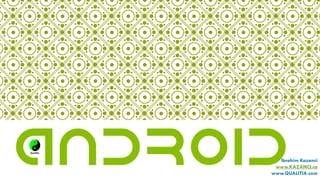Android
- 2. INTRODUCTION ïąA mobile operating system developed by Google, based on the Linux kernel and designed primarily for touchscreen mobile devices such as smartphones and tablets. ïąAndroid's user interface is mainly based on direct manipulation, using touch gestures that loosely correspond to real-world actions. ïąVariants of Android are also used on notebooks, game consoles, digital cameras, and other electronics.
- 3. ORIGIN OF ANDROID âŠAndroid Inc. was founded in Palo Alto, California in October 2003 by Andy Rubin, Rich Miner, Nick Sears, and Chris White. âŠBeginning with the first commercial Android device in September 2008, the operating system has gone through multiple major releases. âŠAs of May 2017, Android has two billion monthly active users, and it has the largest installed base of any operating system.
- 4. FEATURES General: âĒ Messaging, Web browser, Voice-based features, Multi-touch, Multitasking, Screen capture, TV recording, Video calling, Multiple language support Connectivity: âĒ GSM/EDGE, Bluetoot h, LTE, CDMA, EV- DO, UMTS, NFC, IDE N and Wi-MAX. Media: âĒ Streaming media support, External storage.
- 5. CONT.âĶ Hardware support: âĒ Incudes still/video cameras, touchscreens, GPS, accelerometers, gyroscopes, barometers, magnetometers, dedicated gaming controls, proximity and pressure sensors Others: âĒJava support, Handset layouts, Storage, Native Apps, Instant Apps.
- 6. ARCHITECTURE OF ANDROID âĒLinux kernel: âAt the bottom of the layers is Linux - Linux 3.6 with approximately 115 patches. âProvides a level of abstraction between the device hardware and contains all the essential drivers. âhandles all the things that Linux is really good at which take the pain out of interfacing to peripheral hardware. âĒLibraries: âOn top of Linux kernel there is a set of libraries including open-source Web browser engine Web-Kit. âUseful repository for storage and sharing of application data, libraries to play and record audio and video, SSL libraries responsible for Internet security etc.
- 7. CONT.âĶ âĒAndroid Runtime: âThird section of the architecture and available on the second layer from the bottom. âProvides a key component called Dalvik Virtual Machine which is a kind of Java Virtual Machine specially designed and optimized for Android. âAlso provides a set of core libraries which enable Android application developers to write Android applications using standard Java programming language. âĒApplication Framework: âProvides many higher-level services to applications in the form of Java classes.
- 8. DIFFERENT VERSIONS OF ANDROID Version 1.0 Version 1.1 Version 1.5
- 9. CONT.âĶ Version 1.6 Version 2.0 Version 2.2
- 10. CONT.âĶ Version 2.3 Version 3.0 Version 4.0
- 11. CONT.âĶ Version 4.1 Version 4.4 Version 5.0
- 12. CONT.âĶ Version 6.0 Version 7.0 Version 8.0
- 13. APPLICATIONS OF ANDROID OS âĒTurn it into a home media controller âĒTurn it into a kitchen command center âĒUse it as a digital photo frame âĒMake it your live window into the world âĒMake it kid-friendly âĒTurn it into a security camera âĒTurn it into your own personal testing ground
- 14. LIMITATIONS âĒLittle Memory for Storage âĒForce Close on Large App/Games âĒData Connection âĒBattery Problem âĒBox of Malware Google play store
- 15. CONCLUSION oDesigned for mobile and flexibility both in hardware and software. oContains of 5 Layers. oUsed for Application Development. Ibrahim Kazanci www.KAZANCI.ca www.QUALITIA.com
















